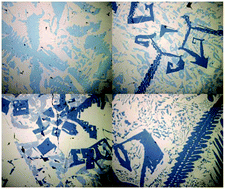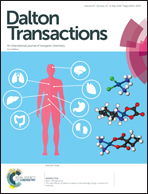Investigation of ternary metal dodecaborides (M1M2M3)B12 (M1, M2 and M3 = Zr, Y, Hf and Gd)†
Abstract
Samples of metal borides with a nominal composition of ((M1)(1−x−z)(M2)(x)(M3)(z)) : 20B (M1, M2 and M3 = Zr, Y, Hf and Gd) were prepared by arc-melting and studied for phase composition (using powder X-ray diffraction (PXRD) and energy dispersive X-ray spectroscopy (EDS)) and mechanical properties (Vickers hardness). Ternary metal dodecaboride phases were successfully synthesized for the majority of compositions, including stabilization of two high-pressure (6.5 GPa) phases (cubic-UB12 structure), HfB12 and GdB12, in (Zr1−x−zHfxGdz) : 20B and (Y1−x−zHfxGdz) : 20B nominal alloy compositions. Unit cell refinement for the samples showed solid solution formation in most cases. Vickers hardness measurements indicated that most samples possess enhanced hardness in comparison to their parent phases, with the alloy (Zr0.50Y0.25Gd0.25) : 20B having a hardness of 46.9 ± 2.4 GPa compared to 41.3 ± 1.1 and 41.6 ± 1.3 GPa for alloy compositions of 1.0 Zr : 20B and 1.0 Y : 20B, respectively, at 0.49 N of applied load. Using the data from this manuscript as well as previous work, pseudo-ternary phase diagrams (at a constant boron content) have been constructed.

- This article is part of the themed collection: Celebrating our 2018 prize and award winners


 Please wait while we load your content...
Please wait while we load your content...
